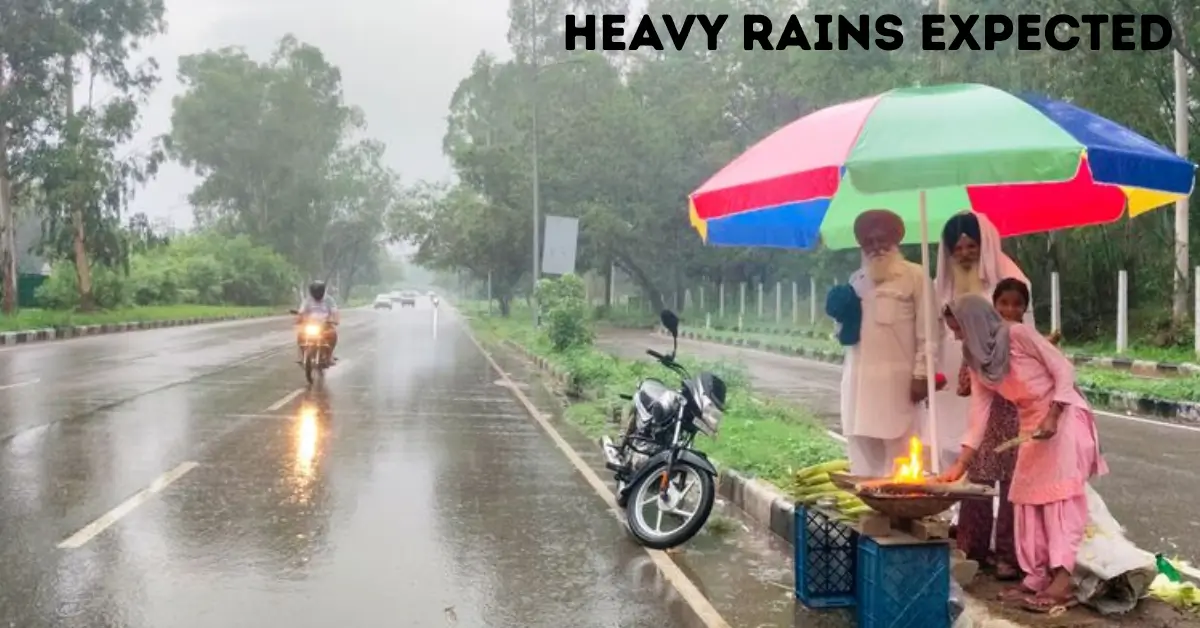Heavy Rains Expected
In a surprising turn of events, the monsoon rains that were thought to have come to an end are now making a return across India. The India Meteorological Department (IMD) has reversed its previous statement, announcing that the monsoon has taken a U-turn. As a result, Heavy Rains Expected in several regions, particularly in Punjab and Haryana, starting on October 6, with yellow alerts issued for October 5 and 7. This sudden shift in weather conditions has raised concerns about the impact on agriculture, crops, and daily life in various parts of the country. Let’s dive into the details of this weather development and its possible effects.
IMD’s Orange Alert for Punjab and Haryana
After initially declaring the end of the monsoon season, the India Meteorological Department (IMD) has issued an orange alert for Punjab and Haryana, signaling that heavy rain is likely to occur on October 6. These areas have been warned of significant rainfall, which could disrupt daily activities. Additionally, the IMD has issued yellow alerts for October 5 and October 7, indicating that rainfall is expected to be lighter, but still noteworthy, during these days.
This shift in the weather pattern is largely due to two active low-pressure systems in the region, which are causing instability in the atmosphere and bringing rainfall back to regions that had previously experienced a dry spell.
CM Punjab GTS Programme Deadline 2025 – Avail Rs.10 Lakh Tractor Subsidy
Active Low-Pressure Systems: Impact on Weather
The IMD has also reported that two low-pressure systems are actively influencing the weather conditions in India. The first system is located in the Gulf of Kutch and the northeast Arabian Sea. This system is expected to intensify and could eventually develop into a depression in the coming 12 to 24 hours. The center of this low-pressure system is currently at 22 degrees north latitude and 68 degrees east longitude, with winds blowing at around 50 kilometers per hour. It is predicted to move in a west-southwest direction toward the northwest Arabian Sea, further affecting the weather in surrounding regions.
The second low-pressure system is located in the west-central Bay of Bengal and has already turned into a depression. Its center is situated at 15.5 degrees north latitude and 86 degrees east longitude, with winds blowing at a speed of 55 to 60 kilometers per hour. Experts warn that this system will likely contribute to increased rainfall across different parts of India in the coming days.
Weather Impact on Different Regions of India
Due to the influence of these low-pressure systems, heavy rain and unstable weather conditions are expected to continue across large parts of India. Some of the regions most affected by the changing weather include:
- Northeast India: Continuous rain is expected in areas like Assam, Meghalaya, and Arunachal Pradesh.
- West Bengal: Cities such as Kolkata and surrounding districts will likely see heavy showers.
- Bihar, Jharkhand, Odisha, and Andhra Pradesh: These states are also predicted to experience persistent rainfall.
- Telangana and Chhattisgarh: Both regions are expected to witness moderate to heavy rain.
- Madhya Pradesh, Maharashtra, Gujarat, Rajasthan, Uttar Pradesh, and Delhi: While these areas are not expected to receive as much rain as the states mentioned above, the weather will still be impacted by the shifting weather systems.
In particular, the hilly areas of North India may experience some bad weather due to the monsoon’s resurgence, with the potential for landslides and flash floods in vulnerable regions.
Pakistan Govt Sponsors Educational Tour to Turkiye for National Matric Toppers 2025
Potential Effects of the Weather Change
This unexpected return of rain after the supposed end of the monsoon season has the potential to cause significant impacts across the country, especially in terms of agriculture and crops. As experts have pointed out, such weather conditions can affect the growth of crops, especially for farmers who have already begun harvesting or sowing the next cycle of crops. Excessive rainfall can damage crops, particularly in the Punjab and Haryana regions, which are heavily dependent on agriculture.
Moreover, continuous rainfall in urban areas may lead to waterlogging, traffic disruptions, and power outages. The IMD has advised residents in affected areas to stay informed about changing weather conditions and take necessary precautions to minimize damage and ensure safety.
Stay Prepared for Unstable Weather Conditions
As the IMD continues to monitor the evolving weather systems, residents in affected regions must stay prepared for the changes in weather conditions. Here are some important tips to stay safe:
- Keep up with official weather alerts: Follow updates from the India Meteorological Department (IMD) for the latest warnings and advisories.
- Prepare for heavy rain: Ensure that your homes are ready for possible waterlogging or flooding, particularly in low-lying areas.
- Protect crops: Farmers should take necessary steps to protect their crops from excessive rain, such as harvesting early or using covers to shield plants.
- Stay indoors: During heavy rain and thunderstorms, it’s best to stay indoors and avoid travel, especially in areas prone to landslides or floods.
Schools on Small Plots Face Closure as Punjab Education Foundation (PEF) Issues Compliance Orders

